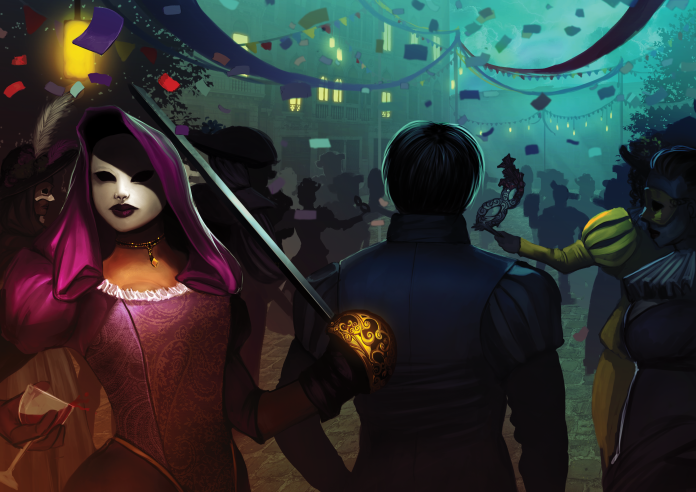A copy of Blood on the Water was provided to Goonhammer by TTCombat for this review.
If you read my previous review of Carnevale and its starter set then you will have (correctly) come to the conclusion that I like this game a fair bit. As such I was more than a little excited to receive an early copy of Blood on the Water, the first major expansion for the game. This book does a few things, including pushing on the narrative of the story considerably, introducing a bunch of new (mostly optional) mechanics, and providing a host of new scenarios to play.
I generally don’t like to bury the lede on these things, so let me come right out: this book is a mixed bag, and I can’t recommend it with the same full-throated enthusiasm as I did the base game. It gets a lot right, but it also makes some bad missteps, and the end result is more muddying the waters than bloodying them.
Venice, 1795
The first sixty pages of this book are taken up with extending the timeline of the setting by a full year, through 1795, and updating us on the factions and their activities. This is the strongest part of this book by far, with compelling narration of some extremely impactful events, alongside absolutely beautiful illustrations. The illustrations are mostly moody and dramatic, trending towards a painterly style that carries over from the original book and suits the text very well. There are some odd exceptions though – the style occasionally dips into a cartoony style which isn’t as good a fit, and this slightly disjointed creative direction is something we’ll come back to later. For now, however, this is the sweet part of the book to be enjoyed, pages and pages of always capable, sometimes great, writing about a setting that is extremely compelling.
The main theme that runs through this writing is escalation – as tensions rise and power struggles reify into bloody violence, a series of vicious assaults leads to outright war in the streets. This rises to a crescendo when the Doge deputises mercenaries into the city guard (nicely aligning with the expanding range for them) and the fighting spills onto the vessels of the Venetian navy.
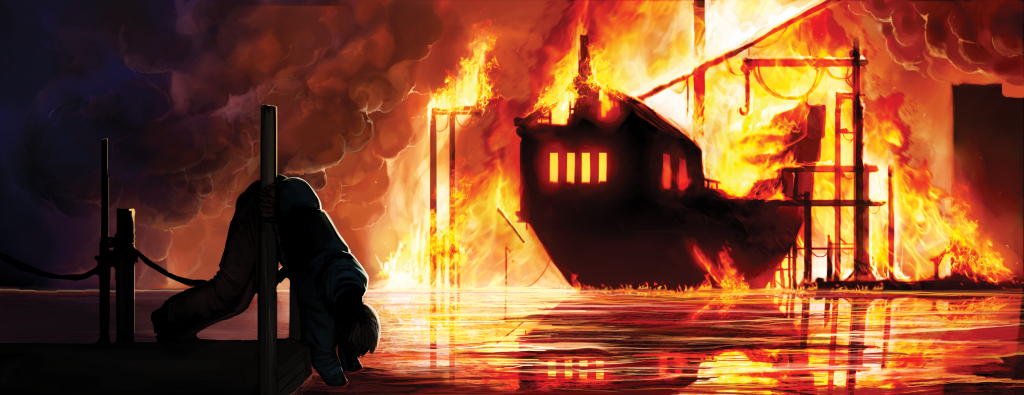
In the next section, the conflicts between the Catholics and the cult of Dagon escalate further, with new crusades launching themselves out of Venice and onto Malta and beyond, opening the action up to areas outside of the Serene Republic.
Meanwhile we have the written records of a member of the Doctors, as these occult researchers encounter the Strigoi and begin to experiment upon captured vampires. This draws the ire of Vlad himself, and again the situation escalates into carnage and chaos.
Even the somewhat calmer and gentler coda to all this, as the World’s Fair of 1795 (not a phrase I ever expected to use) kicks off, pushes an escalation of some of the theatrical violence we’ve seen in the setting before, with the superheroic elements of some of the supernatural characters being heightened in a pulpy and showy way.
All of this is, in and of itself, absolutely fine. Some of it is great – the sections around the clashes between the Guild and the Patricians I like in particular. It definitely tells a coherent and cohesive story of a city (and world) spiralling further and further out of control, with violence escalating harder and faster into something grander and more deadly. My concern is that I’m not sure how Carnevale, a skirmish miniatures game for under a dozen models on each side, can hope to portray all of this in a satisfying way. This feels like the escalation of a setting in terms of scale (and indeed the events portrayed are all an upping of scale – bigger clashes to the size of battles, wider scope of geography at stake, bigger questions to be answered) that demonstrably can’t be handled in the game that currently exists. This is the setting material I would be thrilled to read for the launch of a large battle game based in the same universe. That would make a lot more sense of it – not confined to gangs in the streets of Venice, but instead companies of troops warring across this twisted vision of the Mediterranean. But that’s not what we have here, and it’s an odd mix.
It’s also an odd mix in terms of the illustration, because as I mention some of the pieces are much more light hearted and less realistic, and while that’s fine to some extent, it does make you wonder what tone the developers were striving for. The cover in particular, attractive as it is, raises some questions as to exactly what mood they were going for, because it’s so dramatically at odds with many of the internal illustrations.
In With the New and the Old
Once we’re past the extensive lore section of this book, we plunge into a rendition of the core rules reprinted in full here with updates and additions integrated. This is an excellent choice – this operates as a fully functioning rulebook that doesn’t require you to bring the original with you. It’s a decision I wish more publishers would make (and indeed one I wish TTCombat had made with Dropfleet Commander!) and it means that playing the game is much easier. I can simply grab this book and my case and head out, rather than falling into the 40k syndrome of hauling a library about.
The rules themselves are, therefore, mostly things we’ve seen before and mostly things I’ve been very complimentary about! The key differences are, then, where these rules have changed and the new additions that have been added. I’ll only be going over the major additions here, but TTCombat have run down in detail all the changes on their community site. If I’ve not talked about them here, assume that they’re either good or they’re absolutely fine – for the most part these were streamlining changes and overall an improvement to the game
The first immediately obvious addition is the Fortune’s Favour rule which is included alongside the Golden Rule in a boxed off section as the first and most important part of the Carnevale Rules. This is clearly intended to be a headline addition to the rules, so it’s worth paying it additional attention. Luckily we can include the whole rule as it’s been published online by TTCombat in their advent calendar from last Christmas.

I cannot stand this rule, and I think it’s important to explain a little bit about why.
“Narrative” is a term thrown out a lot in wargaming to describe a certain kind of play or gaming, and it’s an interesting one. It’s often used to describe games where “winning” doesn’t matter – you’re depicting a narrative event and so one side or the other is almost certain to win, and so it’s not a matter of trying to “beat” the other opponent, but play out the game in an enjoyable and interesting way. Narrative gaming of this kind isn’t something everyone likes, but it’s certainly something a lot of people do – lots of classic Games Workshop scenarios work like this, and it’s rife in historical wargaming.
However, Carnevale isn’t a narrative wargame by this metric – there’s not a specific scenario that’s encouraging an outcome, there’s clearly been effort made to make all the missions if not perfectly balanced then at least an interesting contest. The mission sets that build a narrative campaign tend to push the outcome one way or another, and that’s certainly a good argument it falls into that mode of play, but ultimately there are also a good selection of other missions that are intended to be more neutral, and it’s clear the majority of games are played with these. The standard play experience isn’t narrative in that sense, and anyway this rule doesn’t have anything to do with it.
So what does it mean when this rule says “This is a narrative game, after all!”? This leads us into another kind of “narrative game” where the story of what’s happening on the table is very important, not just the “game” aspect of how the mechanics interact. It’s not a specific story, but rather stories themselves that the game attempts to have play out on the table top. There are lots of games that do this to great effect, many of which I love a lot – Chain of Command is one of the few wargames I find interesting to play solo because the way the mechanics hang together means that fascinating stories and narratives will erupt just by playing the game. This is the kind of narrative game that Carnevale attempts to be, and the core rules do this pretty well – the success and failure mechanics of tests, the way that you manipulate the different resources, all of these things create entertaining and unexpected outcomes that, for the most part, fit the theme and characters very well.
So what does Fortune’s Favour add to this? I don’t think it adds anything useful, but since it tells us what it thinks it’s adding (“This core rule gets players to think carefully about their moves and encourages you to make your games more exciting”) let’s evaluate it from that perspective.
The first failing here is definitional – “the first person to perform a particularly dashing feat during a game can be awarded Fortune’s Favour by their opponent”. What constitutes a dashing feat? Is jumping from one roof to another dashing? Is swimming up out of a canal and grabbing an enemy dashing? I honestly don’t know what qualifies and what doesn’t. This isn’t saying “the first person to do something the other person thinks is especially cool or interesting”, as vague as that would be, it’s being more specific than that – dashing. It also suggests “daring and dramatic” as descriptions of actions that should be awarded. It feels immediately that some factions and playstyles are going to be rewarded above others… and there’s already a way to do that, and it’s the entire rest of the rules.
If I bring a very acrobatic character along, like a Guild Capo, they’re going to be running across rooftops and flipping around the whole time. That’s literally the whole point of bringing one along. Is everything they do particularly dashing? Or does “particularly dashing” change depending on what model it’s being applied to? Does one of my random rabble making a chain jump across a canal count because I’d usually fail and have them fall in? Is it connected to success at all?
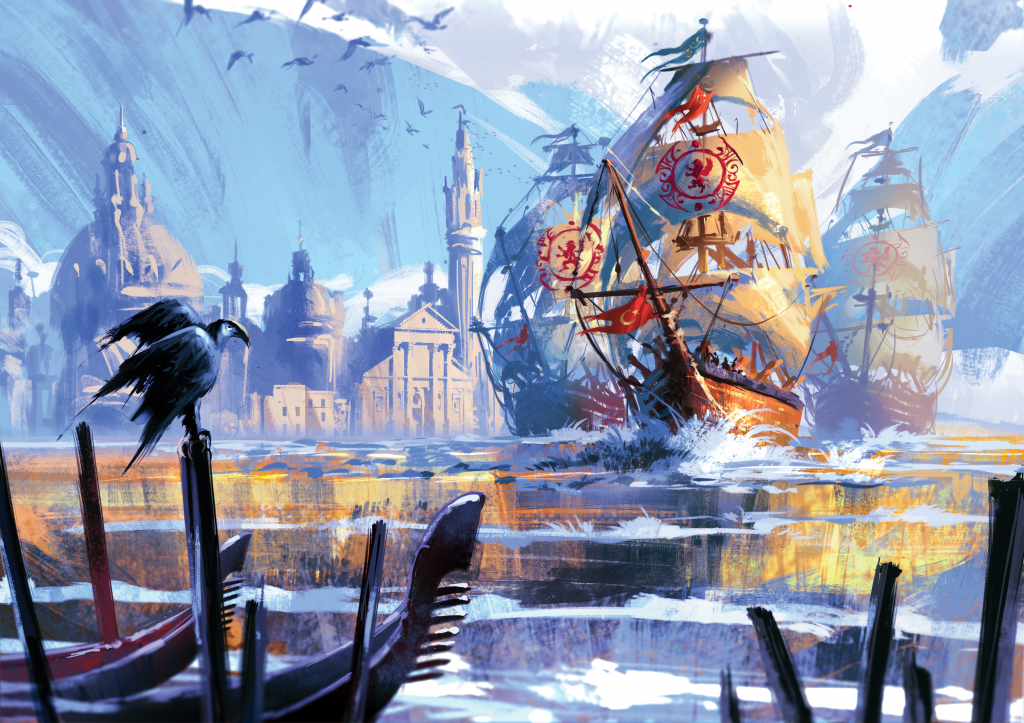
There are no answers here. It’s entirely left to the players to decide. And some might argue that’s fine – why would you play with people who aren’t down for cool and chill gaming who’ll throw that coin around? And hey, I hope my opponents are down for cool and chill gaming, but what we see as cool and chill might not be exactly the same. What happens if I do something I think is cool and they don’t think it is, and so don’t award the coin? What happens if one player is much more “generous” with the coin? There’s a decent benefit to getting the coin, so you want the coin, and, from a competitive perspective (and there is always some degree of competitive perspective because a wargame is versus another player) giving it away is bad. So the incentive is to not give it to your opponent – even if you think people should, the way the mechanics are written is to incentivise a player to not give someone the coin.
Worse, the last section of this text suggests that, maybe, if you win with fortune’s favour, then maybe you haven’t really won, I mean, you have, but have you won a moral victory and honestly I couldn’t have less time for this nonsense. Don’t make someone feel shitty about winning just because they happened to end up with a token their opponent could literally award them, with them having no ability to protest, on the last action of the game.
The thing that’s very frustrating about this is that it really doesn’t add anything. The whole game is making cool, dramatic and dashing plays. When I played before this supplement the game was replete with these memorable moments, where people went for big plays and fell off buildings or managed dashing feats and so on. There was no particular crying need for this rule because this rule doesn’t do anything beyond going “hey isn’t doing cool stuff cool, you should do that cool stuff” and that’s literally the whole game already. So either it’s a completely fluffy narrative rule to encourage cool things, which already existed, or it’s a mechanical boost to get people to do that when they wouldn’t normally, which unfortunately incentivises someone to not use it if they’re that way so inclined. I have no idea who this rule is for.
You may be thinking at this point that I’ve gone on about this rule for what seems like an unreasonable amount of time. “Lupe” you say “come on man, it’s just a silly rule to try and encourage people to have fun” and you’d be right if the same criticism couldn’t be levelled at basically all the additions to the rules here.
The other main rules additions include a reaction system which is honestly just another level of complexity on top of the rule (and even marked as advanced rules suggesting you don’t use them until you’re familiar with the core rules). They certainly give you some advantages, I guess, but they’re kind of picky and minor and the kind of thing that involves a lot of extra fiddling to get a +2 on a dice roll or such. And remember this is, as the rules have told us, a game about making dashing plays, and the narrative. Nothing in the reactions rules add to that. That’s not to say they’re bad in of themselves – they’re fine. In another game, they might be a good addition. But they don’t add anything particularly interesting to the tight, exciting gameplay of the core game.
The Advanced Terrain rules are another big addition, and this I can be more overtly positive about – they’re mostly good, albeit very silly, additions. Hanging platforms, counterweight lifts, ziplines… this is all stuff that’s absolutely fitting that “narrative play” thing with lots more opportunities for emergent catastrophes. It’s also marked as “advanced rules” and that’s a bit of an odd choice – these aren’t any more complex than the core terrain rules, and fit in well.
However past these additions we move into others that are again in the category “but why?”. Rules for explosive barrels are fun, but cannon seems overkill for a “streets of Venice gang violence” game, and murder holes is just a strange addition to a game where you’re climbing around rooftops and not, normally, walking under specific entryways so people can drop things on you. There are also new rules for boats and ships – like, proper ships – which fits with the fluff from the start of the book but again feels like they belong in a different game.
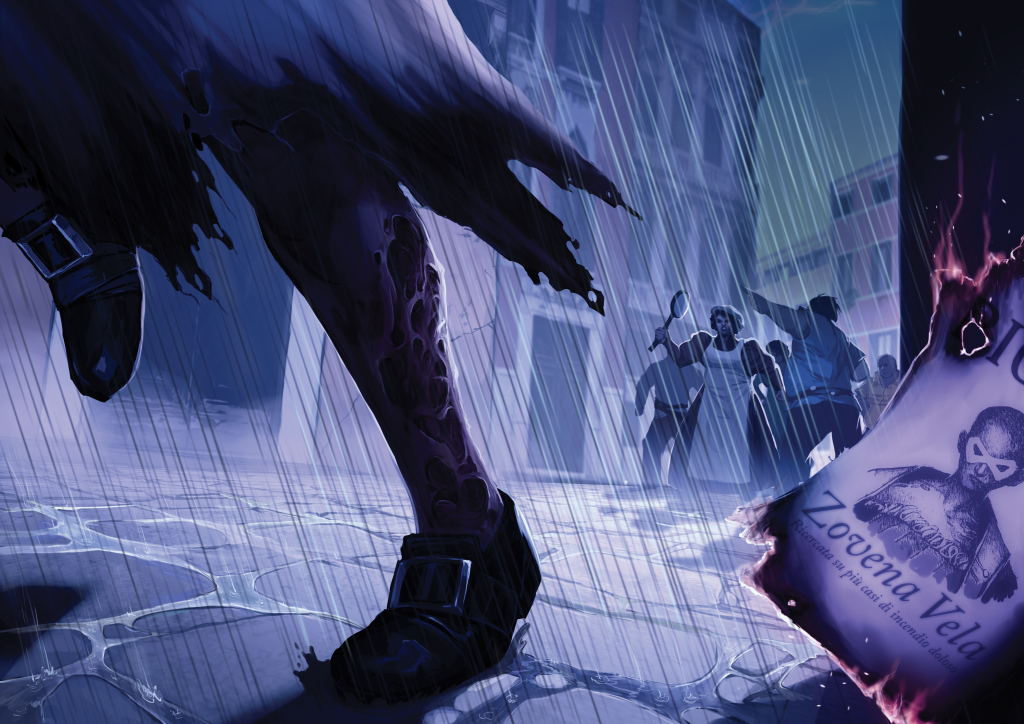
Next up we have a few more equipment options, including “artifacts”, to let you round out the last few ducats of your list more easily. These are fine if not terribly exciting, but they definitely fix a problem which is “I’ve chosen all the models I can and I have 5 or 10 ducats left”. All these new options basically mean this is a solved problem, and that’s a great step up from the core game where that was certainly an issue.
It’s strange, therefore, that the next section then attempts to solve the same problem in a less interesting and more complex way. “Ill Tides” are one-shot negative effects your opponent gets to use on you if you got over your Ducat limit in a list. They’re randomly rolled and they’re an impressive incarnation of anti-fun. Every single one of these abilities is a “spoiler”, that snatches away something you just achieved, or rubs it in when something bad happens. There’s a tide that turns falling after a missed jump into an absolute disaster, and even stops you using a parachute you maybe spent ducats on. There’s another where, when you complete an agenda (the game’s floating objectives) it lets your opponent go “nah that didn’t count” and stop you completing it. It’s all the misery of playing against a blue deck in Magic: the Gathering without the upside of… no I’m not sure what the upside is in that game either. They just come across as weirdly mean and dispiriting.
Put all these additions together and you get… I honestly don’t know. A slightly more bloated, slightly more frustrating, game that’s still underneath really good. The terrain rules are the best thing here, followed closely by the expanded equipment, and honestly if those were the only mechanical changes in the rules I’d probably be praising the decision. The game shines because it’s fast and furious and exciting like the narrative it’s trying to portray, and most of this stuff just slows play down. If I were to speculate I would suggest that most of these rules were written because they were putting out an expansion, rather than because they felt they were great rules that added to the cohesive whole of the game. None of the individual additions (other than Fortune’s Favour which I find mildly incomprehensible) are bad as such, they’re just mostly not needed and they don’t enhance or build on what’s great about the game so much as add more stuff to it.
There’s also a very odd tonal note to all this as well. Some of the rules seem to reflect the moody, overblown and cool, dark but with a note of horrible whimsy, tone that the rest of the book sets up well. One of the artifacts is the death mask of a poet who committed suicide for example, and that fits very nicely – moody, slightly gothic, slightly melodramatic. Literally on the facing page though is a rule to portray if your gang has food poisoning called “Bad Spaghetti”.
Either of these tones is fine. I don’t actually mind which one you go with. But you should probably pick one.
Ultimately it’s not hard to find a path through to only using the good additions to the rules here (drop Fortune’s Favour, reactions, and ill tides, keep the rest) but when you have to choose your own ruleset the designer has dropped the ball. It’s a shame, because the core game remains as good as ever, it’s just also got this cruft that could have been avoided.
A Reason to Fight
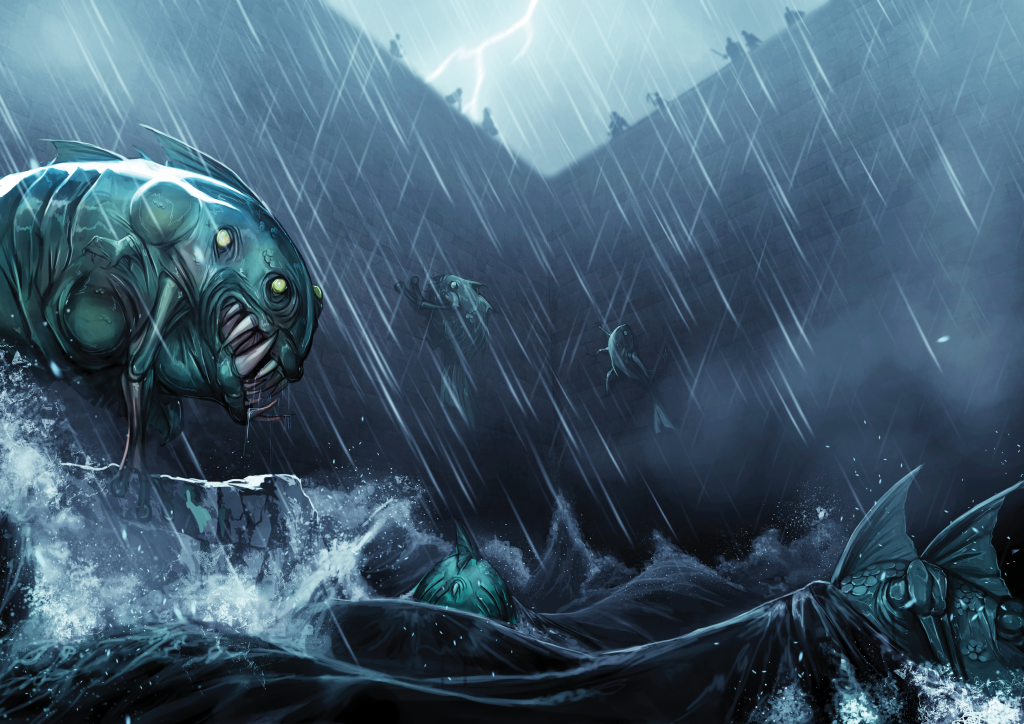
One of my favourite elements of the core rulebook is the inclusion of a number of narrative campaigns made up of linked scenarios, and they’ve doubled down on this approach for the expansion. They’ve also strongly tied these campaigns to the new lore that’s presented in the book, which is a great choice. We end up with three of these campaigns, each one mirroring one of the major sections of lore in the first sixty pages.
The first is Blood on the Water pitching the Patricians against the Guild as the two factions struggle for dominance in Venice and attempt to bring the docks and eventually the Arsenale under their control. It follows the plot beats of the lore material closely, and it’s a fun romp. It’s probably my favourite of the three campaigns as it feels more Carnevale to me, really hitting the thematic beats of the game and the core setting. I particularly enjoy The Crimson Carnival where up to three gangs attack a single Patricians player who gets to set up a rat run with explosive barrels across an unusually long and thin board. Another shout out goes to Skirmish on the Docks where the attacker is attempting to set light to boats and ships in the dock, and which would be a fantastic set piece mission (though one I can’t imagine actually having all the terrain to do it justice!).
The second is The Siege of Malta which lets the Vatican and the Rashaar face off, the clash of the religious factions in the city. Except this isn’t in the city, instead taking place on Malta (as you might expect) as the beasts of the ocean erupt from the sea and attempt to consume the city. It’s a very different take on these factions because it’s also not really about the religious element of the Rashaar, and you’re encouraged not to bring any Church of Dagon models for them, while the Vatican side is (obviously) heavily focused on the Knights of Malta, leaving some of the other characters outside of the scope of the campaign. It’s probably the campaign that’s most thematically restrictive, and it definitely suffers for it in my eyes.
It’s an interesting concept, but you’re going to be portraying a conflict taking place between a small slice of two factions in a location that’s not the standard setting of the game and which you probably don’t have terrain for. It’s also weird because it just transplants the standard table assumptions of the game (mix of canals and solid ground) to a setting where it just doesn’t make sense. Why are there so many canals in Malta all of a sudden? Why would there be canals running alongside forts that are defended by military orders? It’s a very strange choice and not one I like much, even though the individual missions seem interesting.
The last campaign is Bloodbath and this actually takes the step of openly tweaking a lot of the assumptions of what a standard Carnevale board looks like. It’s a clash between the Doctors and the Strigoi and it’s a really fun little romp. You can use the forces that turn up specifically in the lore, but it’s also encouraging of you using different ones, which makes it strangely at odds with The Siege of Malta. I actually really like the unusual tweaks to the board setup in these scenarios with Warehouse Carnage (set entirely inside with some water representing the canal docks that often ran inside warehouses in the city) being a stand out. Dracula’s Rage is also interesting, with Vlad Dracula being an essential part of the Strigoi gang and taking place on a tiny board letting him truly rampage, giving him a special ability to continue to fight even if killed, but stripping his Command Abilities. It’s a really inventive change of pace.
It’s a shame there are no “generic” scenarios included in this book, as in my experience a lot of players use them. It means that while you can use this book as a rules reference alone, you can’t run anything other than the campaign scenarios in here without the core book. I would have liked to have seen those core scenarios reprinted at least, but a couple of new ones would have been a good addition. However, the scenarios in here are mostly great, with two out of the three campaigns being ones I would be very excited to play through.
The Serene Republic One Year Later
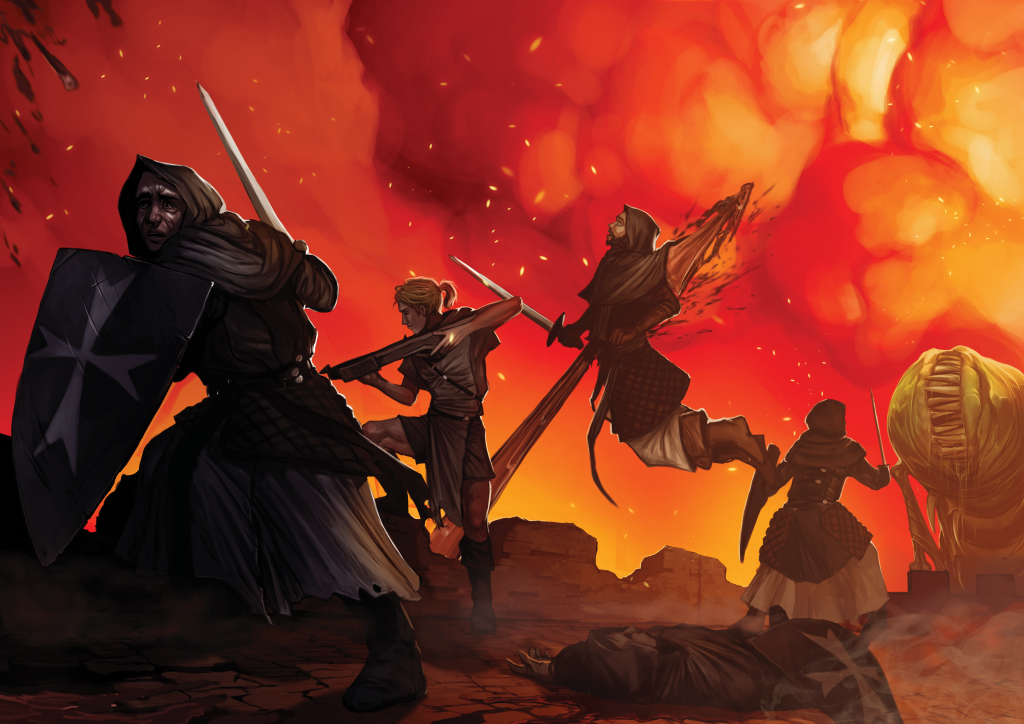
To sum up, Blood on the Water is an extremely mixed bag. The lore and world-building is broadly very strong, with some great additions to the background and setting. There’s also some amazing artwork, and I wish I could get some of these pieces as prints to put on my wall – they’re good enough I want to look at them all the time. However, this is all muddied by the tone being a little off with some of the art – not a deal breaker, but a shame, since all the art is great it just doesn’t all belong together. If you’re a big fan of the Carnevale setting and narrative, then this book is a must buy – a fantastic addition to the storyline and the emerging canon.
The mechanics are what lets this expansion down, sadly. Though there are some good and thematic additions, and some clever solutions to problems from the original edition, there’s too much extra material here that just weighs the experience down rather than improving it. A good expansion makes the core game better, and I just can’t say that this does. You can pick and choose the elements to add, and that probably on balance makes it worth the cost, but if you had to pick between using all of it or none of it, I would probably recommend you don’t use any of it.
That said the game recovers with a lovely selection of new scenarios, including some really innovative and interesting concepts for games. The new board formats and special rules are a great addition and I can see some exciting matches coming out of them.
Overall if you’re an existing Carnevale player it’s probably worth picking this book up, but it’s hard to imagine it sparking off any new interest in the game. Additions but not evolutions, this expansion is a flabby but fascinating book that feels like it falls short of the greatness the core game achieved.
